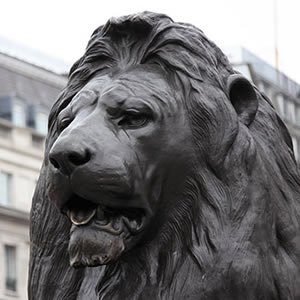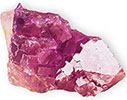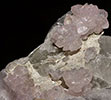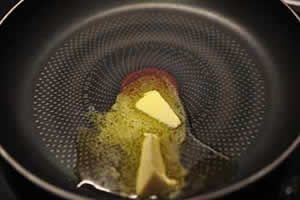Learn
![]()
Physical Properties
You can stretch a rubber band and it will return to its original shape, but you cannot stretch your shoestring very much at all. You can bend a paper clip but you cannot bend a piece of pasta very much. The abilities to stretch and bend are physical properties. After you stretched and bent these items, you still had the same substances: rubber, shoe strings, metal, and pasta. Any characteristic of a material that you can observe without changing the identity of the substance is a physical property. Some examples of physical properties are boiling point, melting point, viscosity, density, hardness, malleability, solubility, shape, size, and color.
Substances can be separated by their physical properties, much like you can separate a can of mixed nuts based on shape. For example, by using a magnet, you could separate metallic objects from non-metallic objects.
- Viscosity is the resistance of flow of a material.
- High viscosity indicates a slow moving fluid, such as peanut butter, honey, or molasses.
- Low viscosity indicates a faster moving fluid, like water, orange juice, and some salad dressings.
- Conductivity is the ability of a material to allow heat to flow. Metal is a good conductor of heat and electricity.
- Malleability is the ability of a material to be hammered without shattering. Most metals have this property.
- Melting point is the temperature in which a substance changes from solid to liquid.
- Boiling point is the temperature in which a substance boils.
- Density, or the volumetric mass density, of a substance is its mass per unit volume.
- Hardness is a measure of how resistant solid matter is to various kinds of permanent shape change when a compressive force is applied. Hardness is measured by using the Mohs hardness scale, shown below. Diamonds are the hardest at 10 while talc is the softest at 1.

| Mineral | Mohs Hardness | Image |
|---|---|---|
| Talc | 1 |  |
| Gypsum | 2 |  |
| Calcite | 3 |  |
| Fluorite | 4 |  |
| Apatite | 5 |  |
| Feldspar | 6 |  |
| Quartz | 7 |  |
| Topaz | 8 |  |
| Corundum | 9 |  |
| Diamond | 10 |  |
![]()
Physical Changes
A physical change is a change in the size, shape, or state of matter in which the identity of the substance remains the same. Some of the properties of the material change but the substance remains the same. When you go to the beauty shop to get your hair cut, you change the length of your hair; however, you have not changed the identity of your hair — it is still hair. Substances can undergo melting and still have the same composition, such as butter. Melting butter is a physical change. Whether the butter is melted into a liquid or cooled into a solid, it is still butter.

You can use a filter to separate coffee grounds from water when making coffee. Filtration is separating based on particle size. You can also separate substances by distillation, which is based on the boiling points of particles in a solution. Water is often separated by distillation.
![]()
Chemical Properties
A chemical property is the ability to produce a change in the composition of matter. Chemical properties are those that can be observed to produce one or more new substances.
Flammability is the tendency of a substance to burn.

Reactivity is the readiness to combine chemically with other substances. Sometimes substances react to form a toxic gas or an explosion.

![]()
Chemical Changes
A chemical change occurs when a substance reacts to form one or more new substances. Baking, changing of leaves and digestion are all examples of chemical changes. As substances burn, they undergo a chemical change. When you put logs in your fireplace they begin to burn. The wood undergoes a chemical change.
There are clues to help determine if a substance undergoes a chemical change:
- Color
- Gas production, indicated by the formation of bubbles
- Precipitate formation, indicated by solid particles in a liquid
Fireworks are chemical changes. Check out the website SciFun to learn more about the chemical changes that occur within fireworks.
Chemicals do not have to mix to undergo a chemical change. Light can cause some medicines and food products to lose their effectiveness. Notice the next time you go to the store that some vitamins are in dark, amber colored bottles. The color of the bottle protects the vitamins from light.

Earlier we discussed that melting butter is a physical change. However, when butter is burned, it undergoes a chemical change.
Rust is also a chemical change. The iron reacts with the oxygen in the atmosphere producing rust.

There are two types of changes:
- Reversible changes, which include melting butter, dissolving salt in water
- Non-reversible changes, which include burning wood and a boiled egg
When two clear solutions of lead nitrate and potassium iodide mix, a reaction takes place and a yellow solid – lead iodide – appears. The yellow solid that is produced in the chemical reaction is called a precipitate.
In this beaker, you can see the solid, yellow precipitate of lead iodide that has formed. Image attribution: Lluvia de oro by Der Kreole is licensed under CC By 3.0.
Watch the video Chemical and Physical Properties and Changes (3:15) to review. Login instructions.
Next, watch this Mythbusters Elephant Toothpaste video (2:50) to see another example of a chemical reaction, or chemical change. Login instructions.
![]()
Conservation of Mass
The Law of Conservation of Mass states that matter is neither created nor destroyed during a chemical change. This law tells us that the mass of all substances that are present before a chemical change will equal the mass of all the substances that remain after the chemical change.
| The Law of Conservation of Mass states: total mass of the reactants = total mass of the products |
Think about the logs you place in your fireplace on a cold winter's night. At the end of the night, the mass may seem to be different than what you initially placed in the fireplace. Suppose you could collect all the oxygen in the air that was combined with the log during the burning, plus all of the smoke and gases that escaped from the burning log, and measure their masses. You would then find that the mass would be the same.

